Thomas Stanley Wakeley, Evangelist Preacher and Businessman 1832-1897
Born at Moor Street Farm on September 1st 1832, one of seven children which included four brothers and three sisters, Thomas had a strict moral upbringing mainly at the hands of his mother. She had a big influence on him, particularly after the death of his father when he was aged seventeen. She gave him his early training in the evangelical religion and instilled in him a strict moral code.
As a boy Thomas liked hunting, shooting and cricket and continued participating until four years after his marriage. In 1856 he became a founder member of the newly formed Rainham Cricket Club along with his brother Richard Mansfield Wakeley and his future father-in-law Thomas Dodd. He was a bit wild as a teenager with an impetuous nature, stubborn with a lot of determination and became well-known as a shrewd and straightforward businessman with an enterprising and energetic mind in the Wakeley Brothers hop, fruit and brick making business after starting off as a corn merchant.
Thomas got involved in several incidents during his teenage years including one while driving his horse and cart from Rochester to Gillingham. As he approached a drawbridge at New Brompton a brewer’s dray came from the opposite direction. The driver and accompanying mate demanded that he turn back but when he refused they threatened him with violence. Thomas took them on, refused to back down and passed into Gillingham.
Richard Wakeley wrote of his brother in his book ‘Gathered Fragments:’
He had one day been playing in a cricket match about sixteen miles from home, and staying later than most of his eleven who had previously left in a coach and taking more stimulant than was good for him, he became excited, and having a very fast horse, determined to overtake them. To do this he drove at such a furious pace for about eight miles that a friend who was with him became greatly alarmed; then overtaking the coach, he threw the reins into the hands of his companion saying, ‘Now you drive,’ and sitting down in the cart went to sleep…’
Richard Wakeley goes on to describe his brother’s attitude when hunting.
And here I might name that during the very time when my brother was labouring under strong convictions of sin, he went one day to the hunting field to follow the hounds as usual. Always a bold and fearless rider, he surpassed himself in hardihood on that last and memorable occasion; and going quite against his conscience, and urged on, no doubt, by the power of Satan, he rode in such a desperate manner that when he reached home at the close of the day his horse had not a single shoe left to his feet…’
In 1855 Thomas married Marianne Dodd, daughter of Rainham farmer Thomas Dodd and went on to have several children. In 1859 he had a serious accident when he badly cut his wrist in an accident. After this he became concerned about his sins and dedicated himself to religion which dominated the remainder of his life.
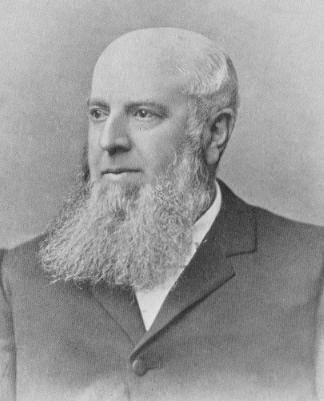
Photo of Thomas Stanley Wakeley, Evangelist Preacher and Businessman
During the late 1850s he viewed himself as a sinner in a letter written to his brothers.
‘I have been a dreadful sinner, but I feel that His mercies are greater than my sins.’
In his early days as a preacher Thomas Wakeley held prayer meetings in the Old Granary at Otterham Quay and in the school room in Rainham but moved to Borstal near Rochester in 1862 where he attended an evangelical church and learnt the doctrine. He eventually became dissatisfied with it and left. He moved back to Rainham in 1864 and remained there until his death.
During the mid-19th century Thomas and his brothers started Wakeley Brothers Fruit and Hop business in Rainham and a brick making business in Poot Lane Upchurch where they had the bricks transported by rail to Twinney Creek then on to different locations along the coast by barge. However, Thomas regarded religion as being more important than business stating in his diary dated March 5th 1860:
‘May I be no speculator as regards religion. No, I cannot; religion is a reality, not a speculation. Religion, with Christ for its basis, is beyond a worldling’s ideas; beyond his farthest thoughts of happiness, little though I can speak about it.’
After becoming ill in Brighton in 1864 he survived after fears for his life then from 1865 he studied religion more seriously. He read intensively including the work of John Bunyon and John Wesley and began preaching at meetings in both Upchurch and Rainham with a range of hymns and readings. He also became involved with the Temperance Movement and collected £75 to build a reading room in Rainham. After this in 1865 he stopped preaching in Upchurch and began meetings in the new Rainham reading room which had been recently built. Meetings continued there until October 1884 when Providence Chapel opened after being constructed in Orchard Street. Thomas Wakeley regularly preached there until his death.
During the 1870s and 1880s Thomas attended church meetings in other parts of the country such as Rotherfield, Wimbledon, Brighton, Hastings and Leicester but on November 8th 1874 he wrote that he felt like giving up preaching, a feeling that recurred at different times along with periods of self-doubt and depression. In 1876 he fell ill again and went to Margate for a change of air. He returned after a week feeling better and wrote to his sons urging them to follow the correct religious path.
During the 1880s he remained active in the family business and was instrumental in selling land at Wakeley’s Church Farm for the construction of the Infant’s School in Upchurch.
In 1897, towards the end of his life, Thomas Wakeley continued to have periods of illness and depression then in August 1897 he announced that he would never preach again. He gradually recovered then preached for the last time in Brighton over the Easter weekend but he fell ill and couldn’t continue. He went to Ticehurst in Sussex to recover but deteriorated and died there on May 27th 1897. His body was brought back to Rainham where he was laid to rest in the churchyard and a tablet was placed over the pulpit of Providence Chapel in his memory.
David Wood
- Details
- Category: History Articles
Christmas 1923 - Butchers Shop in Rainham
It might have been shortly after the end of the First World War but this photo shows a well stocked Rainham butcher's shop in December for Christmas 1923. This Rainham Cooperative shop in 17 Station Road Rainham Kent displays 100% English fare, home killed beef, pork, mutton, turkey, rabbit, duck and home made sausages.
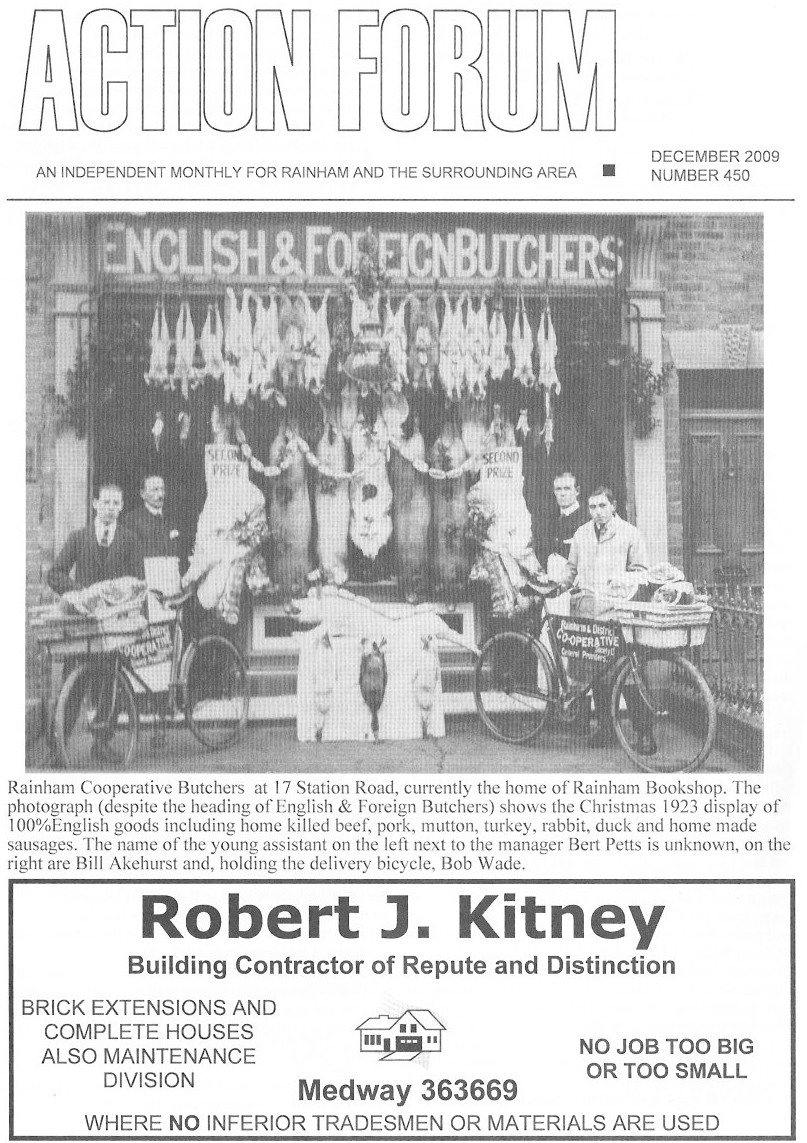
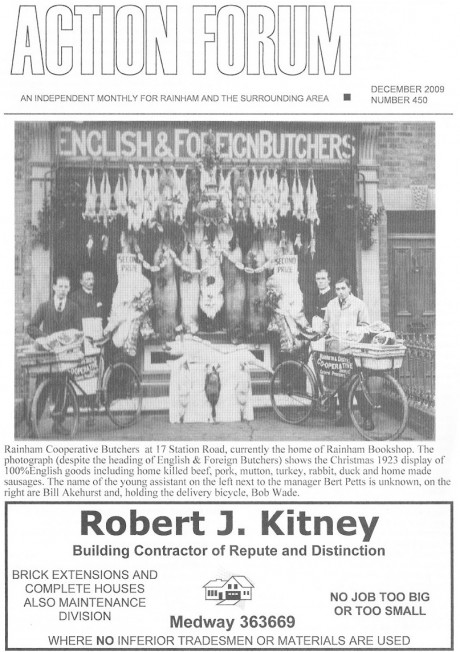
Rainham Co-operative Butchers at 17 Station Road. The photo shows the Christmas 1923 display of 100% English goods including home killed beef, pork, mutton, turkey, rabbit, duck and home made sausages.
The manager was Bert Petts, also pictured are Bill Akehurst and Bob Wade with the delivery bike.
- Details
- Category: History Articles
Reverend Charles Cobb – Real Life Hero and Long Serving Vicar of Rainham
Born in 1828 and the son of Captain Thomas Cobb of New Romney, he lived until 90 years old and became one of the oldest clergy in the country. He served as vicar of Rainham for 32 years from 1876 to 1908 and became one of the most popular and well respected clergymen to have worked the parish.
Charles Cobb entered the holy orders in 1853 after he had obtained his MA degree at Corpus Christi College, Cambridge. After this he held curacies at Halstead, St Nicholas-at-Wade, Lambeth and Minster Sheppey. In 1860 he was appointed Rector at Dymchurch where he remained for sixteen years.
While serving in Dymchurch he carried out a heroic act for which he gained widespread praise and fame. ‘The Sunday Pictorial’ dated 29th March 1936, reported that during a fierce gale on January 5th 1867 a French lugger named ‘Corrier de Dieppe’ which had been blown badly off course got wrecked on Dymchurch Sands. The coastguards tried to fire a lifeline aboard to rescue the crew but it fell short. After this three of the crew were washed into the sea and drowned but one sailor remained clinging to the rigging. A coastguard named John Batist tried to battle his way to the wreck in rough sea and strong wind but failed. Reverend Cobb, a powerful swimmer, arrived and against the wishes of some parishioners who were also present he took off his coat, dived into the sea and swam to the wreck where he reached the stranded sailor. Soon after this Batist, the coastguard, also reached the vessel and helped Reverend Cobb haul the sailor to safety.
For his act of heroism Reverend Cobb received many awards which included a gold medal from The National Lifeboat Institution in 1867 and the Albert Medal from Napoleon 111 of France. He later had a photograph of himself wearing his medals with a framed certificate from the National Lifeboat Association displayed on the wall at Rainham vicarage. John Batist who had assisted in the rescue received a bronze medal.
Later in 1876 Charles Cobb became vicar of Rainham and got fully involved in the church and local activities. During the late 1870s and early 1880s he played as a successful opening batsman for Rainham Cricket Club and also made many friends in the parish. 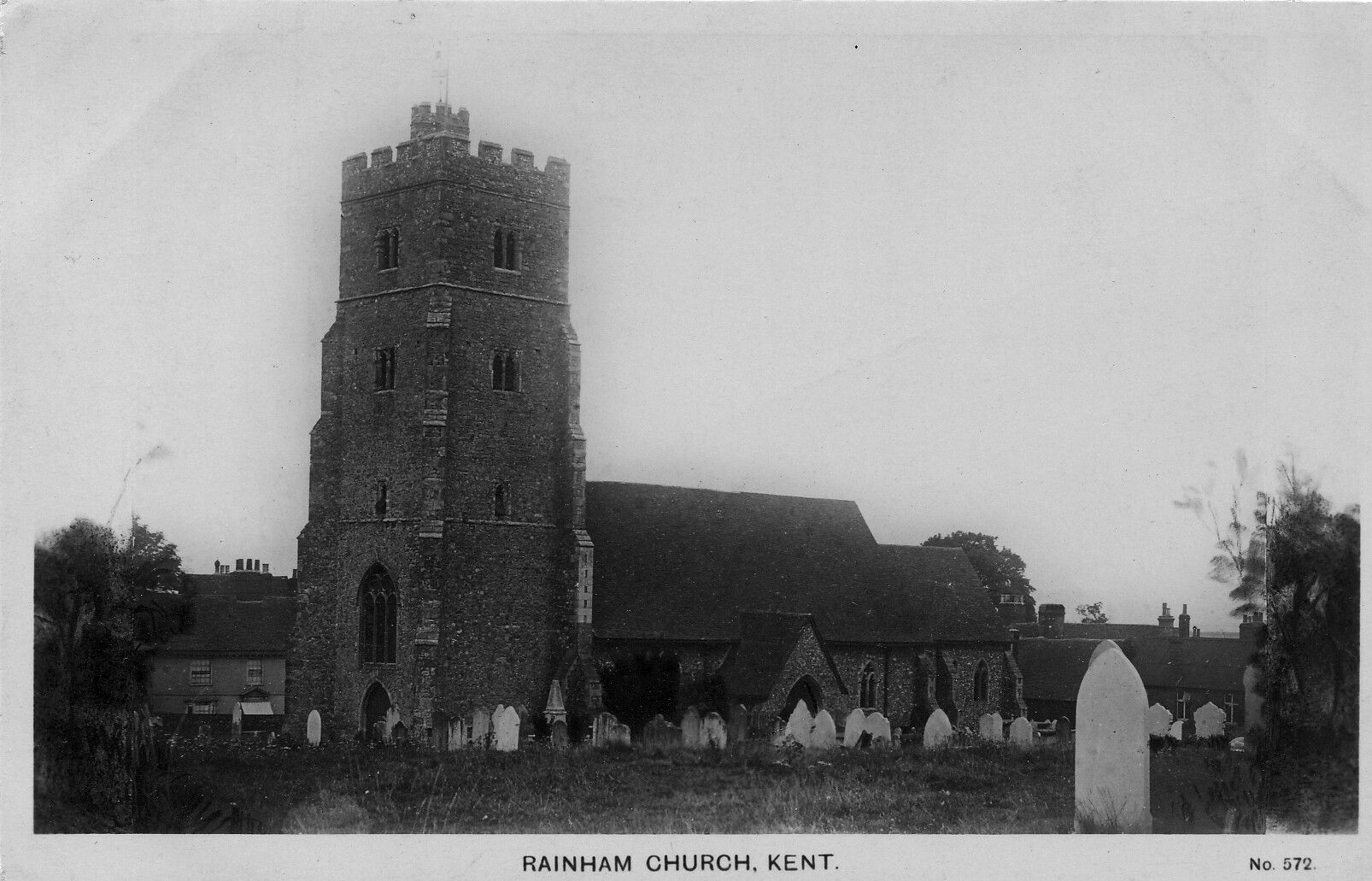
After his wife died in 1903 Reverend Cobb continued as vicar of Rainham until 1908 then resigned. Reverend Tamplin succeeded him and married his daughter. Reverend Cobb continued to reside at the vicarage and maintained a role at the church taking services when his health allowed him to do so. He regularly presided over intercession services in the church during World War 1. Held in high esteem during the time he resided in Rainham, he died in 1918 and was buried in the churchyard.
After his death the parishioners of Rainham, as a mark of respect and recognition of his services, presented the church with a new communion table and a communion plate in his memory. David Wood.
- Details
- Category: History Articles
Upchurch Pottery in Rainham
Although the pottery is named after the village of Upchurch the business started in Rainham when Seymour and Dora Wakeley who had an interest in pottery, had a bottle and kiln workshop constructed in a chalk pit just off Seymour Road on Wakeley family land. While designer Edward Spencer gave a helping hand and advice, Dora Wakeley spent her free time obtaining clay and Roman pots from the Upchurch marshes, had her designs made into her own wares and exhibited these in London at places like Crystal Palace. She described her business to the East Kent Gazette dated March 20th 1920.
“I was first interested in the potter’s art as a hobby. When I started in a very small way before the war I little dreamt that it would develop into a revived history. I enjoyed hunting round museums for designs and most of my models have been copied from Chinese and Korean wares of the 15th century. I supply Upchurch pottery to several West-End firms and as a result of this fair I have been asked to accept far more orders than I can ever hope to execute.”
At the beginning conditions for producing pottery at the workshop were basic without gas or electricity, kick wheels were used to turn the pots and water was obtained and brought to the workshop from a nearby pond. The coal fired kiln proved to be very unpredictable and the clay obtained locally. Despite these problems Upchurch pottery became well-known far and wide over time.
Potter Ted Baker who resided at Windmill Hill in Upchurch became a major reason why the pottery obtained its fame. He had originally worked with his father in the family flower pot business when he left school. He then spent some time in London where he worked in Reginald Wells’s pottery in Chelsea. Wells became a personal friend of Seymour Wakeley.
Ted Baker returned to Kent from London in 1913 and Seymour Wakeley immediately employed him as a potter at his workshop. The designs Baker worked on were mainly influenced by Greek and Roman vases and he used a style of soft colours with a matt finish. This became a characteristic of Upchurch Pottery. His glaze recipe books show that he used a large amount of boracic which intensifies colour and reduces expansion of the glaze to prevent cracking. The pottery had extraordinary and delicate colouring. The pots were fired to a great heat, up to 2,000 degrees, which caused unexpected colour effects. Dora Wakeley continued to be responsible for designs put into practice by Ted Baker, and designer Edward Spencer advised and collaborated with him with regard to glaze recipes.
During the 1920s Upchurch glazes lost popularity, described by some experts as being sombre and stolid but after 1933 the glazes became more pastel and softer. Ted Baker perfected this characteristic, and the products were exhibited at major trade fairs. His work became very popular and in demand. The pottery obtained so much fame that Queen Mary became a patron.
Due to the deterioration of the Seymour Road building the original site for the Upchurch Pottery was demolished in 1936 and Seymour Wakeley sold the business to Oscar and Grace Davies who opened the Roeginga Pottery in Rainham High Street. It only operated under them for two years but they recruited Ted Baker’s son Edward to manage it. Mrs Alice Winnecott then purchased the pottery, hired the services of Ted Baker and developed the Claverdon Range of pottery which became very popular. A thatched roof Tudor café and a pottery shop set in gardens and lawn existed close to the Man of Kent pub to attract potential customers travelling along the A2.
Although the Roeginga pottery didn’t function during World War Two it re-opened in 1948 and Ted Baker became the subject of a black and white film made at the pottery which showed the different stages of manufacture in pot making and the business did well with 200 items being produced in 1949, most of which were exported abroad.
During the summer months travellers on the way to the coast frequently stopped to watch Ted Baker at work in the pottery. After making enough money he eventually purchased the business from Mrs Winnecott in 1953. He then ran it as his own business with his two sons and they made pots for clients all over the world but in 1955 he died. Edward Baker junior then bought the business in 1956 and renamed it Rainham Pottery. After 18 more years it finally closed in 1963 mainly due to the competition of cheaper, mass produced ware and the construction of the M2 motorway which took away a lot of trade. Edward Baker continued to run the Roeginga pottery until he retired in 1975.
Today Upchurch pottery is still in demand, a style well-known in the porcelain market nationwide and is recognizable by its distinctive colouring and finishing.
- Details
- Category: History Articles
The Rainham Hero of Lucknow
At the turn of the 19th century a tall, upright and well-built man became a familiar figure on the streets of Rainham. He lived at 109 High Street, he took great pride in his appearance, people noticed that he polished his shoes every day and he wore a row of military medals on special occasions.
Born in Tarbert, County Kerry in Ireland in 1830, Cornelius Sparling joined the 81st Regiment of Foot as a twenty year old. Sent to India he completed 21 years of service on the continent and played an important part in the Indian Mutiny of 1857.
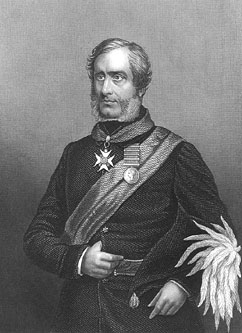 Sir Henry Havelock
Sir Henry Havelock
Serving under Sir Henry Havelock he took part in the march on Lucknow in Uttar Pradesh where Sepoys in the army had mutinied against their British rulers because during their gun loading process they had to bite cartridges believed to be greased with pork and beef fat for their Enfield rifles which violated the religions of Muslim and Hindu troops. During the ensuing conflict Sparling rescued a regimental officer named Lieutenant Roberts who went on to become a field marshal in the British army.
During the course of the rescue Lieutenant Roberts mounted the shoulders of Sparling and nailed the colours to the flag mast that had earlier been shot down from the British residency building. The men did this while under heavy fire from the Sepoys and they were lucky not to be killed or wounded. While the siege of Lucknow progressed Sparling could not escape until the British relief column arrived.
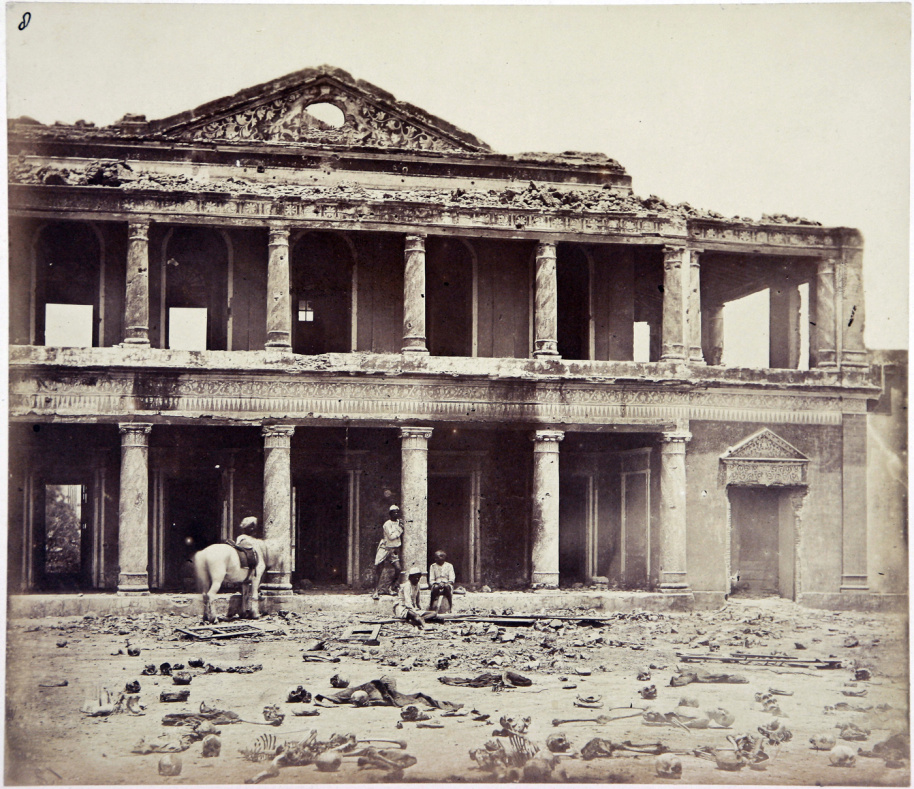 The siege and relief of the city cost the British 2,500 killed, wounded or missing. After this Sparling marched with his regiment to relieve Cawnpore which had been captured by Indian forces, but they arrived too late to prevent the massacre of 120 women and children based there. After the British had surrendered Cawnpore to the Indians in return for safe passage to Allahabad, the men were executed and the women and children hacked to death with meat cleavers and their remains thrown into a well to conceal the evidence. This led to retaliatory counter atrocities by the outraged British relief force soldiers who killed an estimated 7,000 Indian locals and executed many of the leaders of the mutiny.
The siege and relief of the city cost the British 2,500 killed, wounded or missing. After this Sparling marched with his regiment to relieve Cawnpore which had been captured by Indian forces, but they arrived too late to prevent the massacre of 120 women and children based there. After the British had surrendered Cawnpore to the Indians in return for safe passage to Allahabad, the men were executed and the women and children hacked to death with meat cleavers and their remains thrown into a well to conceal the evidence. This led to retaliatory counter atrocities by the outraged British relief force soldiers who killed an estimated 7,000 Indian locals and executed many of the leaders of the mutiny.
After the siege and the massacre at Cawnpore Cornelius Sparling remained in India where he completed his service. As a result of his part played in the Indian Mutiny he received the Mutiny Medal with two clasps engraved ‘Lucknow’ and ‘Defence of Lucknow.’ He also received the ‘Good Conduct’ medal.
When Cornelius returned to England and lived in Gillingham former lieutenant Lord Roberts twice visited him. He then moved to Rainham where he became a familiar figure who regularly worshipped at St Margaret’s church and became a member of the Men’s Bible Class.
When Cornelius died aged 84 in 1914, 50 soldiers from Chatham accompanied by General Mullaly, Commandant of the Thames and Medway area, visited St Margaret’s church where Cornelius was given a full military funeral, the first in the village for about 30 years. With his coffin draped in the Union Jack and escorted by members of the West Kent Regiment, three volleys were fired over his grave as a final farewell to the Rainham hero of Lucknow.
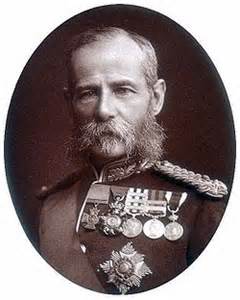
- Details
- Category: History Articles
Subcategories
Historical tales Article Count: 3
Historical tales
Rainham Life Article Count: 10
Rainham Life
Local Events Article Count: 48
Local Events
Photos Article Count: 143
Photos
Action Forum Article Count: 231
Action Forum is a free monthly magazine that is distributed to the Rainham area covering Wigmore, Parkwood and Hempstead as well. This archive covers old copies of the magazine dating back to its initial publication in 1969 and give a fascinating glimpse into life in Rainham over the last 50 years.
Link to Article Index - Action Forum Index - Photos and Articles from 1969 onwards
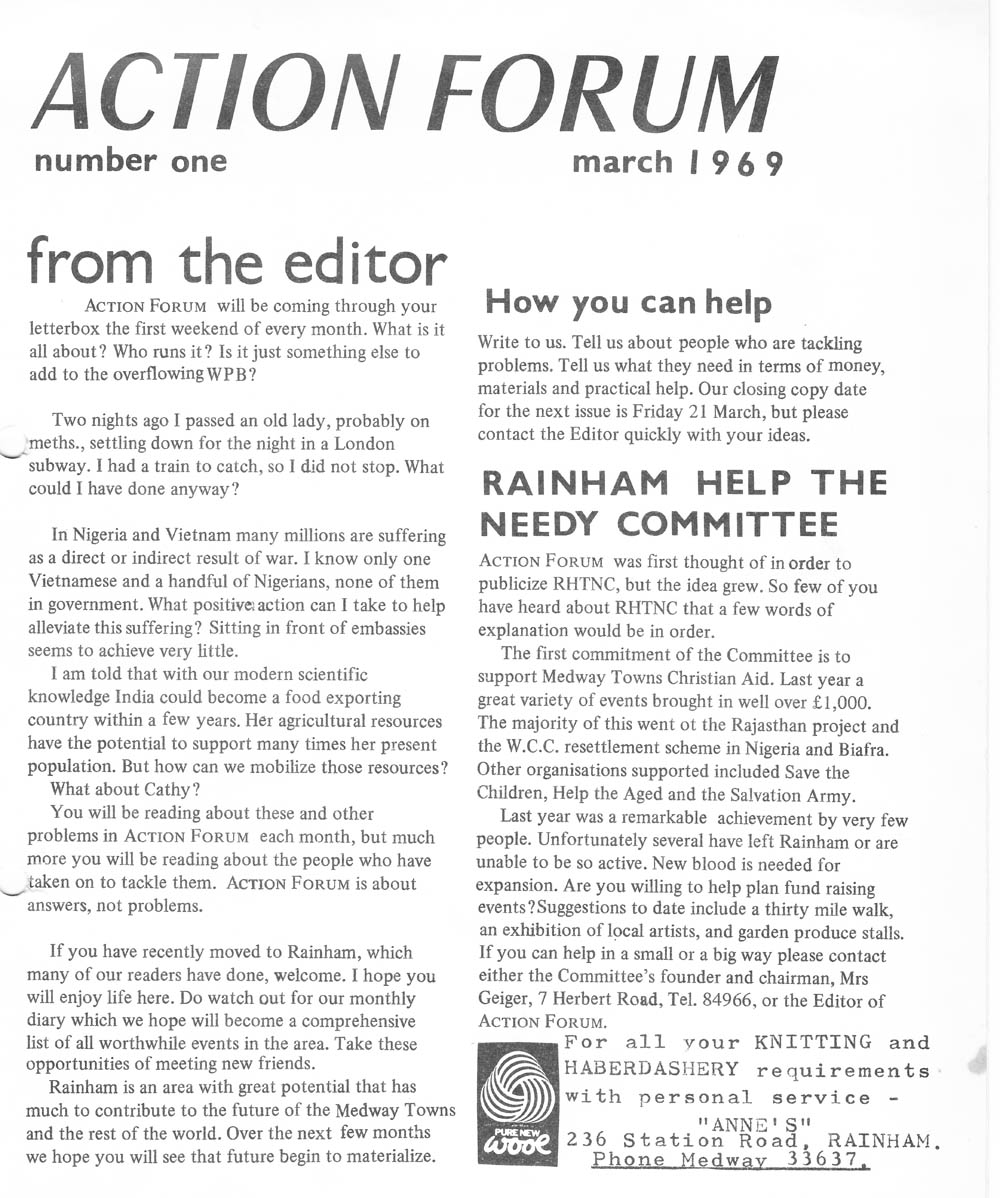

Page 5 of 9


